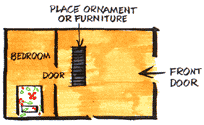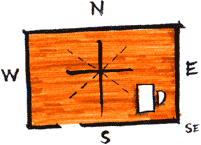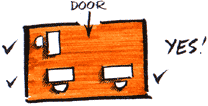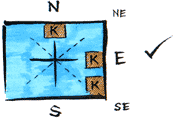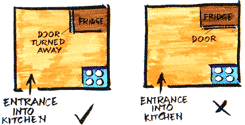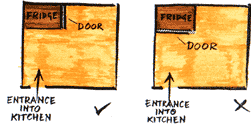FENG SHUI
Importance of Arrangement in Feng Shui

INTERIOR ARRANGEMENT IN FENG SHUI
You can use the principles of Feng Shui to position your furniture and interior décor in such a manner that it maximises the positive influences and minimises the negative ones. It is important to balance Yin and Yang. It is important to maintain harmony and balance in the home and can be achieved through strategic positioning of objects and the use of colour and light.
The left side of a room is the powerful Dragon, and on the right is the sleeping Tiger. Place things in constant use, such as clocks, electrical equipment etc. to the left, which is the symbol of power. The opposite half, belonging to the sleeping Tiger, must be kept quiet, calm and static.
The importance of arrangements in Feng Shui
Before we take to the actual scriptures, let's start with some quick tips from these practical case studies. You shall see how the art of Feng Shui takes stock of the minutest things in furniture placement.
A psychologist once moved into her new office, a large room with two over-sized windows and three doors (too many!). Key pieces of furniture - sofa for the clients, chair for the therapist, and a desk chair - had their backs to the room's entrance. Now, this is a no-no in Feng Shui because you should have an unrestricted view of the door so you can see who comes into the room.
The furniture needed to be re-positioned for unobstructed view of the entry-point. Two long sheer curtains in natural colors were hung from large brass rods over doors that were not in use (on that note, the ratio of one door to three windows in a room is considered auspicious in Feng Shui). A large leafy fern was placed on a pedestal table in a corner behind the diagonally placed sofa. The room was transformed.
On entering the room now, a healing serenity welcomed therapist and client. Sashaying curtains were hung to diffuse the strong window light. (Excess Chi from harsh light rushes out the windows, carrying money and opportunities.) As per the auspicious number code - nine green saplings were placed under the windows to strengthen the healing atmosphere. The therapist smiled and admitted feeling energized.
You shall see in Feng Shui that along with correct placement of key furniture to control Chi, the use of natural color palette, sensual textures, tempered sound and even fragrance is also necessary. For example, Chinese Feng Shui masters believe every room should have a touch of true Chinese red, because red is considered the color of luck, power, and energy. But remember just a touch! For in Feng Shui, less is generally more.
Emperor yellow, the second most auspicious color in Feng Shui, is excellent for a narrow wall with a gentle glaze of raw amber and a flick of Vermillion red. A dreary dining corner can be transformed with a sunny yellow print tablecloth, tempered with a border of red, blue, and green and family spirits at dinner are lifted instantly. If you like blue, indigo is preferred in classical Feng Shui, as it comes from the seven colours of the rainbow and the refractions from cut crystal.
Symbolism is very far-reaching in its effect on emotions and states of mind, so be attentive to what is on your walls. An art-collecting family had two dismal images facing people entering their homes. One was a painting of a dead fish, the other - an exhausted woman hanging laundry. Both were by well-known artists, but this hardly altered the negative energies projected. Happily, the paintings were replaced with better ones - with positive Chi.
Interior doorways are dramatized in Asian and European houses to control the flow of Chi. In a London apartment, moving from one space to another is marked by floor-length door curtains of heavy bronze velvet tied back with tasseled ropes (tassels are considered lucky and suggest Chi energy). Japanese indigo-dye cotton curtains veil the upper third of doorways to control over-strong Chi movement; their designs of flowing water and fish are reflections of nature. Carved wood panels mounted on lintels subtly suggest the character of the room beyond.
In many cultures, there is the belief that empty corners harbor spirit mischief. Thus, flower arrangements, sculpture, screens, corner cabinets, and ferns are placed to create effect in corners, adding a gentle softness to a room. Curiously, appropriate treatment of corners, especially the placement of ferns and flowers, subtly raises the energy of a room.
The moral of the story being - Unlike Vaastu more than directions, Feng Shui stresses on arrangement.
| The Living Room |
Since it is the one room where all the occupants of a house gather, the atmosphere is thick with Yang. Clocks, televisions, fans and air conditioners are in constant use and have an all-encompassing effect. A round clock in white or gold in the west or northwest section of the room brings good luck. The best position is on the left side of the room and if possible, on the same wall as the main door leading into the room. |
| Paintings for the Living Room : Follow these points to maximise the positive influences in your house. |
|
Plants for the Living Room : Most plants have a positive influence as long as they are not wilting. Cactii and plants with sharp spiky leaves are best kept out the home. Plastic or artificial plants are neutral and do not affect Feng Shui. |
Carpets in the Living Room : Choose carpets and rugs in colours that correspond to the direction you place them in. Carpets that cover the whole room should suit the direction of the room itself. If it is in the southeast part of the house, its colour should be green. |
Pets : |
|
| The Dining Room |
|
| The Bedroom |
The bedroom, a very important room, is primarily associated with relaxation and comfort. A person needs to be sufficiently rested to perform well during the day. |
|
If the main door of a flat is directly opposite the bedroom door, the occupant of that room will face legal problems. Position a small decoration or a piece of furniture to interrupt the line of passage. |
Bunk Beds : One's head should not touch the ceiling or this could result in ill health. The top of the mattress should also be atleast 16 inches off the ground. |
| Clocks : It is not propitious to keep a clock immediately behind or directly in front of a sleeper. Clocks should be placed on either side of the bed. |
| Light Bulbs : |
|
A light bulb directly above the head of the bed will turn the sleeper in to a nervous wreck. If hung above the centre of the bed, it will cause stomach disorders. The light should be placed to the side of the bed. |
| Dressing Table : |
|
The dressing table should not be placed at the foot of a bed as it adversely affects health. Move the dressing table to any other position. |
| Bed Headboards : |
You can draw on the strengths of the elements by choosing a headboard that corresponds to your element. |
| Round Shaped Headboards : |
|
A round-shaped headboard belongs to the metal element. It is a good shape to choose, if you work in an office or are involved in paperwork. |
| Square or Rectangular Shaped Headboard : |
Square or rectangular shaped headboards are for people who represent wood and earth elements. It is also good for professionals, as it encourages stability and offers support. |
| Oval or Wave-Shaped Headboard : |
|
Oval or wavy-shaped headboards are ideal for people who belong to the element water and also for artists, musicians and designers. |
| Angular Headboards : |
|
These are not recommended for anyone. It relates to the element fire. It prevents people from getting a good night's sleep. |
| The Study |
Desks are associated with career, and need to be well set up to take advantage of the position. |
| Desk positions : |
|
|
|
| Other Pointers about Desks : |
|
| The Kitchen |
The kitchen is associated with health and affects the general well-being of the family. The strategic positioning of the kitchen and the cooking appliances induce the free flow of energies. |
| The Best Position for the Kitchen : |
|
The best position for the kitchen is in the north, east and southeast corners of the house.
|
| The Cooking Range |
|
| The Cooking Range : |
|
| The Fridge |
|
| The Fridge : |
|
| The Sink |
|
Er. Rameshwar Prasad invites you to the Wonderful World of Feng Shui
Engineer Rameshwar Prasad(B.Tech., M.Tech., P.G.D.C.A., P.G.D.M.) Vaastu International
|

